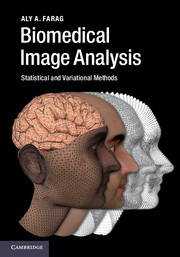Book contents
- Frontmatter
- Dedication
- Contents
- Preface
- Nomenclature
- 1 Overview of biomedical image analysis
- Part I Signals and systems, image formation, and image modality
- Part II Stochastic models
- Part III Computational geometry
- 8 Basics of topology and computational geometry
- 9 Geometric features extraction
- Part IV Variational approaches and level sets
- Part V Image analysis tools
- Index
- References
8 - Basics of topology and computational geometry
from Part III - Computational geometry
Published online by Cambridge University Press: 05 November 2014
- Frontmatter
- Dedication
- Contents
- Preface
- Nomenclature
- 1 Overview of biomedical image analysis
- Part I Signals and systems, image formation, and image modality
- Part II Stochastic models
- Part III Computational geometry
- 8 Basics of topology and computational geometry
- 9 Geometric features extraction
- Part IV Variational approaches and level sets
- Part V Image analysis tools
- Index
- References
Summary
Introduction
Topology is a branch of mathematics that describes objects using geometry, set theory, and group theory. Geometry deals with primitive figures such as triangles, parallelograms, and polygons. Geometric operations measure lengths, angles and areas of shapes, their congruence, and transformations based on scale, translation, and rotation. These functions are commonly denoted as isometries. Topology deals with such matters as well, but in a more global fashion and with complicated shapes. Computational geometry, a field which started in the 1970s, deals with object models that pertain to computing and visualization. Computational geometry and topology share various terminologies, and both deal with shape modeling.
Advances in data acquisition have enabled reconstruction of high-quality three-dimensional models, on which computational geometry is used for modeling and visualization. Section 8.2 deals with shape representation, as a starting point for geometrical and topological analysis. Section 8.3 deals with topologically equivalent shapes and various entities that define surfaces as manifolds. We consider topological properties of points, curves, and surfaces. We are particularly interested in boundary-based shape representations where the geometrical structure can be described in a parametric form (Section 8.5) or in a piece-wise linear form (Section 8.6). Bézier curves and surfaces are popular parametric surface models. Such models are studied together with polygons, triangles, meshes, curvatures, shape indices, and curvedness.
Information
- Type
- Chapter
- Information
- Biomedical Image AnalysisStatistical and Variational Methods, pp. 183 - 212Publisher: Cambridge University PressPrint publication year: 2014
